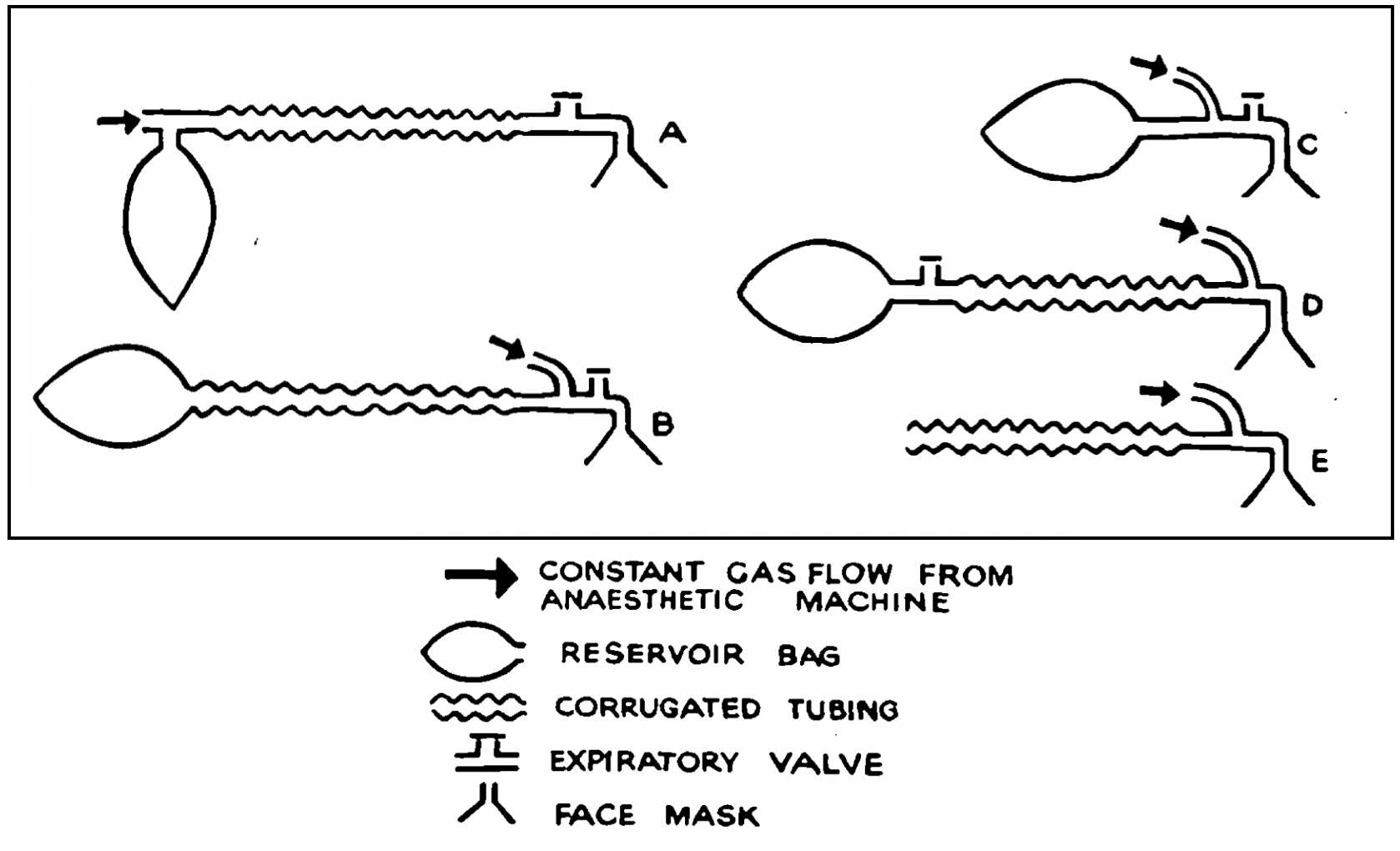The Mapleson Bag is a crucial tool in anesthesia. It helps control the patient’s breathing during surgery.
Understanding the Mapleson Bag is essential for both medical professionals and students. This device, designed for simplicity and effectiveness, plays a vital role in providing safe anesthesia. It is named after Dr. William Mapleson, who developed this system to enhance patient care.
Whether you are new to anesthesia or need a refresher, learning about the Mapleson Bag can improve your skills and knowledge. This introduction will offer insights into its design, usage, and benefits in medical settings. Dive in to discover how this essential tool makes a difference in patient care.

Credit: www.mercurymed.com
Contents
Introduction To Mapleson Bag
The Mapleson Bag is a key component in anesthesia delivery systems. It plays a crucial role in ensuring patients receive the right amount of anesthetic gases. Understanding its purpose and history can help us appreciate its importance in medical procedures.
Purpose And Function
The Mapleson Bag helps control the flow of anesthetic gases. It allows anesthetists to manually ventilate patients during surgery. The bag’s design ensures a consistent and safe delivery of gases. It also helps in monitoring the patient’s breathing. This is essential for maintaining proper respiratory function during anesthesia.
Historical Background
Dr. William Mapleson developed the Mapleson Bag in the 1950s. It was part of his research on efficient anesthesia delivery systems. Before its invention, anesthesia methods were less reliable. The Mapleson Bag improved the safety and effectiveness of these procedures. Today, it remains a vital tool in modern anesthesia practice.
Components Of Mapleson System
The Mapleson system is a vital component in anesthetic practices. It ensures efficient delivery of anesthetic gases to patients. Understanding its components is crucial for safe and effective use. This section breaks down the key parts of the Mapleson system.
Reservoir Bag
The reservoir bag is an essential part of the Mapleson system. It stores the gases delivered to the patient. This bag allows the anesthetist to control the volume of gas. It ensures there is enough supply for each breath.
The reservoir bag is made from durable, flexible material. This material can withstand repeated inflation and deflation. The bag’s size can vary, usually between 0.5 to 3 liters. This variation helps accommodate different patient sizes and needs.
Breathing Tubes
The breathing tubes connect the reservoir bag to the patient. They transport the gas mixture from the bag to the patient. These tubes are typically corrugated. This design prevents kinking and ensures smooth gas flow.
Breathing tubes come in different lengths and diameters. The choice depends on the patient’s size and the required gas flow rate. Properly sized tubes are crucial for effective ventilation. They minimize resistance and ensure the patient gets the right amount of gas.
Breathing tubes are also made from materials that are easy to clean. This reduces the risk of infection and ensures patient safety. Regular checks and maintenance of these tubes are necessary.
Types Of Mapleson Circuits
The Mapleson circuits are a collection of anesthetic breathing systems. They are primarily used in anesthesia to deliver gases to patients. Each circuit has unique features and is suitable for specific clinical scenarios. This section will cover the different types of Mapleson circuits.
Mapleson A
Mapleson A is ideal for spontaneous respiration. It has a fresh gas flow (FGF) near the patient’s face. The expiratory valve is placed at the end of the system. This setup helps in the effective removal of carbon dioxide. Below is a simple representation:
| Component | Location |
|---|---|
| Fresh Gas Flow | Near patient’s face |
| Expiratory Valve | End of the system |
Mapleson B
Mapleson B is less efficient than Mapleson A. It is not widely used. The fresh gas flow and expiratory valve are closer together. This configuration can lead to higher fresh gas flow requirements.
Mapleson C
Mapleson C is a compact version of Mapleson B. It has a similar setup but with a shorter length. This circuit is useful in emergency situations. It is often used in resuscitation.
Mapleson D
Mapleson D is designed for controlled ventilation. The fresh gas flow is placed near the patient. An adjustable pressure-limiting (APL) valve is present. This circuit is often used in operating rooms.
- Fresh Gas Flow: Near the patient
- APL Valve: Present
Mapleson E
Mapleson E is also known as the Ayre’s T-piece. It is simple and efficient for spontaneous breathing. There is no expiratory valve. This setup reduces resistance to breathing.
- Fresh Gas Flow: Near the patient
- No Expiratory Valve
Mapleson F
Mapleson F is also called the Jackson-Rees modification. It is an improvement of Mapleson E. A reservoir bag is added to collect expired gases. This bag helps in controlled ventilation. It is often used in pediatric anesthesia.
Credit: litfl.com
Advantages Of Mapleson Systems
The Mapleson systems have been a staple in anesthesia practice for many years. They offer several benefits that make them a preferred choice in various medical settings. Below, we will explore some of the key advantages of Mapleson systems.
Ease Of Use
Mapleson systems are user-friendly. They require minimal adjustments and are straightforward to operate. This simplicity reduces the risk of user error, especially important in high-stress environments.
The design of these systems is intuitive. It allows healthcare professionals to quickly understand and manage the equipment. This is particularly beneficial for trainees and less experienced staff.
Cost Efficiency
Mapleson systems are cost-effective. They do not require expensive, advanced technology. This makes them accessible to a wide range of healthcare facilities, including those with limited budgets.
Maintenance costs are low. The simplicity of the system means fewer parts that can fail. This reduces the need for frequent repairs and replacements, further saving money over time.
| Advantage | Details |
|---|---|
| Ease of Use | Simple operation, reduced user error, intuitive design |
| Cost Efficiency | Low initial cost, minimal maintenance expenses |
Limitations And Challenges
Mapleson Bags are widely used in anesthesia. They help deliver a controlled flow of gas to patients. Despite their usefulness, they have limitations and challenges. Understanding these can help improve patient safety.
Gas Consumption
Mapleson Bags can lead to high gas consumption. The system requires a continuous flow of fresh gas. This can be costly. It also impacts the environment. In resource-limited settings, this can be a serious issue.
Risk Of Hypoxia
The risk of hypoxia is another concern. If the fresh gas flow is too low, the patient may not get enough oxygen. This can lead to dangerous situations. Constant monitoring is required to avoid this risk. Adjusting the flow rate is crucial. It ensures the patient receives enough oxygen.
Clinical Applications
The Mapleson bag is a key tool in anesthesia and emergency medicine. It is used to manage patients’ airways effectively. Below, we explore its clinical applications in detail.
Pediatric Anesthesia
In pediatric anesthesia, the Mapleson bag is essential. Children have smaller airways, making them more sensitive to anesthesia. The Mapleson bag helps deliver precise doses of anesthetic gas. It allows for better control of ventilation.
Doctors prefer the Mapleson D system for children. It has a high fresh gas flow, which reduces the risk of rebreathing. This is especially important in children to ensure they receive the correct gas mixture. The system is lightweight and easy to use, ideal for pediatric patients.
Emergency Situations
The Mapleson bag is also vital in emergency situations. Quick and effective ventilation can save lives. The bag is simple, reliable, and easy to use, even for less experienced providers.
In emergencies, the Mapleson C system is often used. It provides a high concentration of oxygen. This is crucial for patients in respiratory distress. The system is compact and portable, making it suitable for various settings, including ambulances and emergency rooms.
Emergency providers can quickly assess and adjust ventilation with the Mapleson bag. This flexibility is critical in life-threatening scenarios.
| Mapleson System | Pediatric Use | Emergency Use |
|---|---|---|
| Mapleson A | Not preferred | Rarely used |
| Mapleson B | Limited use | Occasional use |
| Mapleson C | Not preferred | Commonly used |
| Mapleson D | Preferred | Used in specific cases |
| Mapleson E | Limited use | Limited use |
| Mapleson F | Occasional use | Not preferred |
Maintenance And Safety
Maintaining and ensuring the safety of a Mapleson Bag is crucial. Regular checks and proper cleaning can extend its lifespan. Let’s explore the best practices for keeping your Mapleson Bag in top condition.
Regular Inspection
Conduct a thorough inspection every week. Look for any visible damage like cracks or tears. Check the connectors and tubes for leaks. Use the following checklist:
- Examine the bag for holes or wear
- Inspect the tubing for cracks
- Ensure all connectors fit tightly
- Test the valve for proper functioning
Early detection of issues can prevent failures during use.
Cleaning Protocols
Cleaning the Mapleson Bag is essential for safety. Follow these steps:
- Disassemble the bag and tubing
- Rinse each part with warm water
- Use a mild detergent to clean the surfaces
- Rinse thoroughly to remove soap residue
- Dry each part completely before reassembling
For deeper cleaning, consider using a disinfectant approved for medical equipment. Ensure all parts are dry to prevent bacteria growth.
Regular cleaning and inspections ensure the Mapleson Bag operates safely and effectively.
Future Trends In Anesthesia
The field of anesthesia is evolving quickly. Future trends will shape how anesthesia is practiced and delivered. Among these, the Mapleson Bag is expected to see significant advancements. Let’s explore these exciting trends under two key areas: technological advancements and sustainable practices.
Technological Advancements
In the coming years, the Mapleson Bag will benefit from new technologies. These advancements will improve patient safety and efficiency. Here are some key developments:
- Automation: Advanced sensors and AI will monitor patient vitals and adjust the Mapleson Bag automatically.
- Integration: The bag will connect with hospital systems, allowing real-time data sharing.
- Customization: New designs will cater to different patient needs, offering better comfort and outcomes.
These technologies will make anesthesia more precise and reliable. They will also reduce the workload on healthcare providers.
Sustainable Practices
Sustainability is becoming a priority in healthcare. The Mapleson Bag is no exception. Here are some ways it will become more eco-friendly:
| Practice | Description |
|---|---|
| Reusable Materials | Using materials that can be sterilized and reused reduces waste. |
| Energy Efficiency | New designs will use less energy, benefiting the environment. |
| Recycling Programs | Hospitals will implement programs to recycle old equipment. |
These practices will help in reducing the carbon footprint of anesthesia. They will also ensure a healthier planet for future generations.
Credit: www.maskinduction.com
Frequently Asked Questions
What Is A Mapleson Bag Used For?
A Mapleson bag is used for manual ventilation during anesthesia. It helps control breathing.
How Does A Mapleson Bag Work?
The bag fills with oxygen. When squeezed, it pushes air into the patient’s lungs.
Are There Different Types Of Mapleson Bags?
Yes, there are several types. Each has specific uses and benefits in anesthesia care.
Conclusion
The Mapleson bag offers essential benefits in medical settings. It’s easy to use and enhances patient safety. Understanding its function helps ensure better care. Choose the right Mapleson bag for your needs. Always prioritize patient comfort and effectiveness. This device remains crucial for many medical professionals.
Stay informed and make the best choices for your practice. Thanks for reading and stay safe.


